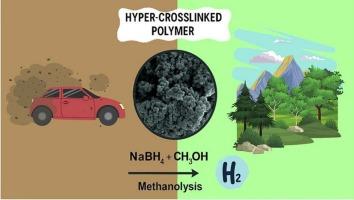三苯基膦功能化超交联聚合物用于硼氢化钠甲醇解高效制氢
IF 5.1
3区 工程技术
Q1 CHEMISTRY, APPLIED
引用次数: 0
摘要
以4,4′-双(氯甲基)-1,1′-联苯为交联剂,与包括三苯基膦(TPP)在内的多种芳香单体通过Friedel-Crafts烷基化反应合成了4种新型超交联聚合物HCP-1 ~ HCP-4。这些聚合物被设计为硼氢化钠甲醇裂解制氢的无金属催化剂。利用FT-IR, XPS, BET, TGA, SEM和zeta电位分析进行综合表征,证实该材料具有热稳定性,具有不规则形态和明显表面电荷的多孔网络。在303.15 K条件下,HCP-3表现出最高的催化活性,产氢速率为9857 mL H2 min−1 g−1,活化能最低(Ea = 32.0 kJ mol−1)。在较高温度(333.15 K)下,HCP-2的活性最高(37200 mL H2 min - 1 g - 1),这反映了温度对性能趋势的强烈影响。尽管HCP-3的比表面积和孔体积不是最高的,但在303.15 K时的优异活性突出了微孔结构、静电表面特性和杂原子功能的决定性作用。Zeta电位分析显示,反应后表面电荷显著减少,特别是HCP-3,表明与BH₄−离子有强烈的静电相互作用。XPS数据进一步证实了TPP和杂芳烃单元的成功结合,这与催化效率的提高有关。总的来说,这些发现强调了一种表面介导的机制,其中电荷辅助氢化物吸引和结构拓扑都控制着氢的演化。这些催化剂的无金属和可重复使用特性支持了它们在可持续氢技术中的潜力。本文章由计算机程序翻译,如有差异,请以英文原文为准。

Triphenylphosphine-functionalized hyper-crosslinked polymers for efficient hydrogen generation via sodium borohydride methanolysis
Four novel hyper-crosslinked polymers (HCP-1 to HCP-4) were synthesized via Friedel–Crafts alkylation using 4,4′-bis(chloromethyl)-1,1′-biphenyl as the crosslinker and various aromatic monomers including triphenylphosphine (TPP). These polymers were designed as metal-free catalysts for hydrogen generation via sodium borohydride methanolysis. Comprehensive characterization using FT-IR, XPS, BET, TGA, SEM, and zeta potential analyses confirmed that the materials possess thermally stable, porous networks with irregular morphologies and distinct surface charges. Under practical conditions, HCP-3 exhibited the highest catalytic activity with a hydrogen generation rate of 9857 mL H2 min−1 g−1 at 303.15 K and the lowest activation energy (Ea = 32.0 kJ mol−1). At elevated temperature (333.15 K), HCP-2 achieved the highest activity (37,200 mL H2 min−1 g−1), reflecting the strong influence of temperature on performance trends. Despite not having the highest surface area or pore volume, the superior activity of HCP-3 at 303.15 K highlights the decisive roles of microporous architecture, electrostatic surface characteristics, and heteroatom functionality. Zeta potential analysis revealed significant reductions in surface charge after reaction, particularly for HCP-3, suggesting strong electrostatic interactions with BH₄− ions. XPS data further confirmed the successful incorporation of TPP and heteroaromatic units, correlating with enhanced catalytic efficiency. Overall, the findings underscore a surface-mediated mechanism where both charge-assisted hydride attraction and structural topology govern hydrogen evolution. The metal-free and reusable nature of these catalysts supports their potential in sustainable hydrogen technologies.
求助全文
通过发布文献求助,成功后即可免费获取论文全文。
去求助
来源期刊

Reactive & Functional Polymers
工程技术-高分子科学
CiteScore
8.90
自引率
5.90%
发文量
259
审稿时长
27 days
期刊介绍:
Reactive & Functional Polymers provides a forum to disseminate original ideas, concepts and developments in the science and technology of polymers with functional groups, which impart specific chemical reactivity or physical, chemical, structural, biological, and pharmacological functionality. The scope covers organic polymers, acting for instance as reagents, catalysts, templates, ion-exchangers, selective sorbents, chelating or antimicrobial agents, drug carriers, sensors, membranes, and hydrogels. This also includes reactive cross-linkable prepolymers and high-performance thermosetting polymers, natural or degradable polymers, conducting polymers, and porous polymers.
Original research articles must contain thorough molecular and material characterization data on synthesis of the above polymers in combination with their applications. Applications include but are not limited to catalysis, water or effluent treatment, separations and recovery, electronics and information storage, energy conversion, encapsulation, or adhesion.
 求助内容:
求助内容: 应助结果提醒方式:
应助结果提醒方式:


